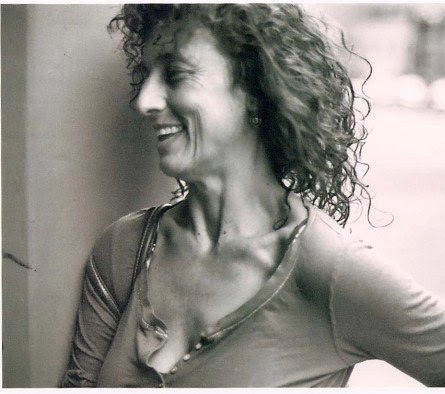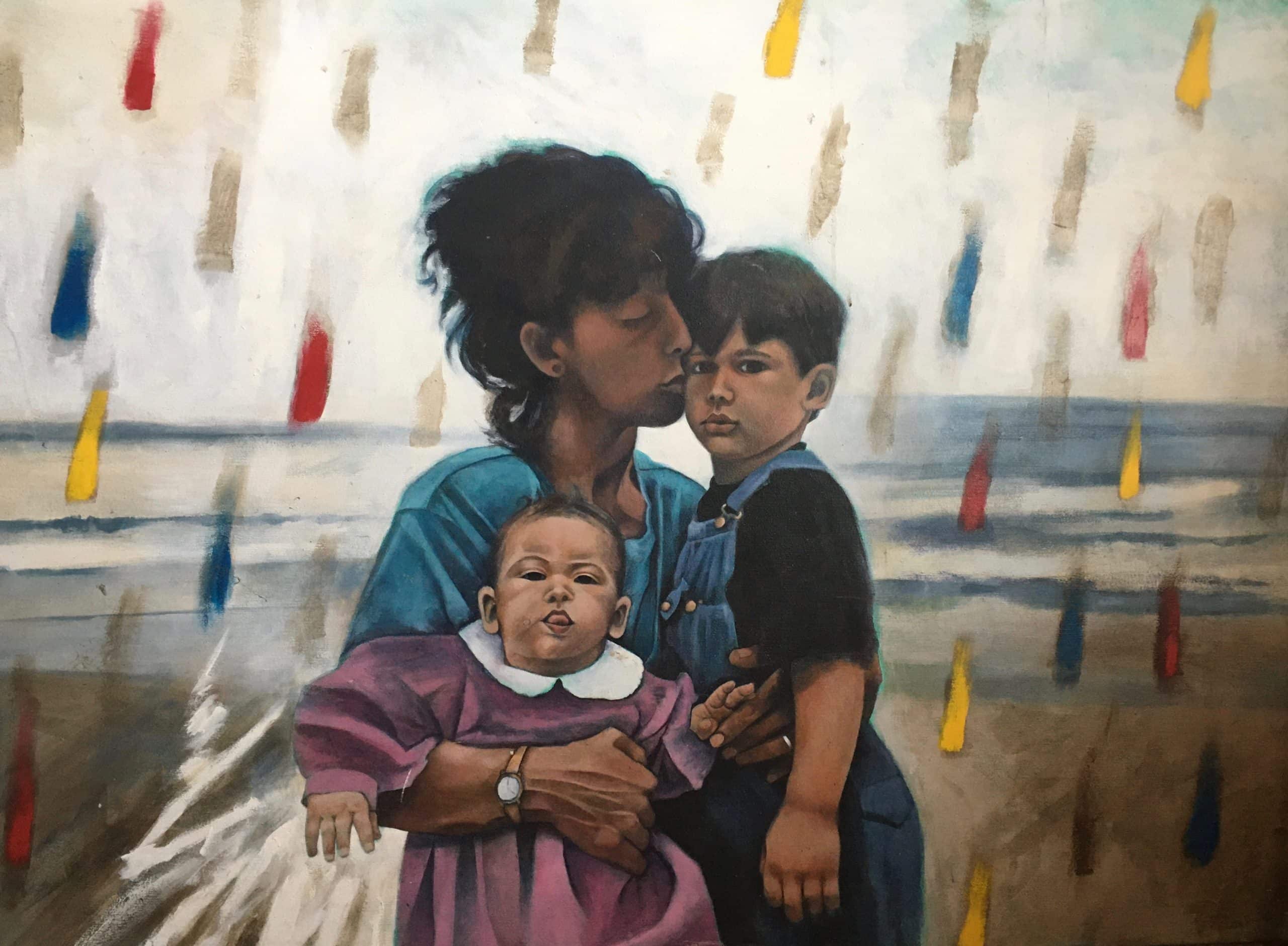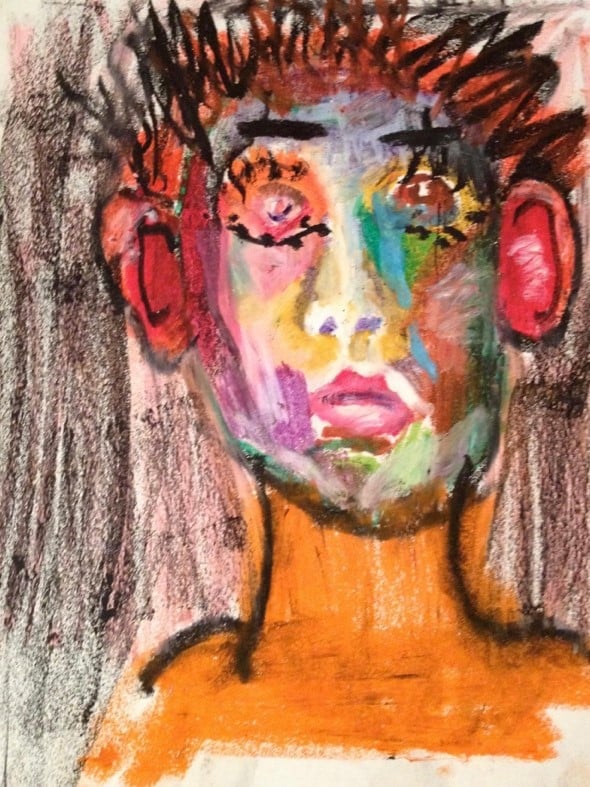Self-portrait by Nick O’Rourke, age 15
By Miriam Feldman
My husband and I are driving to Paris from the south of France. I am in the passenger seat, writing ideas for a story about our son, on a napkin. Our son, Nick, has schizophrenia.
You see, I am the self-appointed conservator of his legacy. I have no complete poem, painting or song to present. Yet. Scraps of a life, one piled up on the other, form the work of art that is his story. I will continue to document his life and put it into the world for as long as I am here. Perhaps he is stricken, but perhaps he is just too magnificent for this world, a blazing light they don’t have eyes to see. But I see. A mother’s eyes can always see. Super tough, I can look directly at an eclipse without damage. Blindness is not an option.
*
When he was still inside of me, a tiny little tadpole boy swimming around, my husband and I heard his heartbeat for the first time. Back in those days they didn’t do sonograms without a medical reason, so the mystery of an unborn child was a universe of questions. We sat in the doctor’s office as she placed the stethoscope on my belly, and the sound came whooshing through a speaker. It was like the repetitive slap of water on some distant ocean shore. My husband blanched and reached behind him for a chair, then sat down hard. He had to breathe into a paper bag, overwhelmed by the sound of Nick’s beating heart.
Afterwards, we went to a small Ukrainian restaurant to have lunch. I ordered soup. It was particularly delicious, and I tried to figure out why. Staring at the bowl, I noticed the way the carrots had been cut. They weren’t the usual uniform disks, graduating in size from the thick part of the carrot to the tip. They were crazy random shapes, as though the cook had performed a wild cutlery dance, shiny blades flying. There were circles, half-moons, rectangles…little snippets of carrot that defied description. That was why the soup was so good. Something about the constellation of shapes enhanced the flavor, made it more interesting. When something arrives in an unexpected form it holds adventure, interest, mystery.
Nick arrived six months later and filled our world with his own configurations of unexpected stars. Some were beautiful, some had sharp edges that cut.
*
Driving along a grey serpent of highway, we descend into a valley. Immediately, I see the blue and red lights. It is the blue that catches your eye. We are all used to seeing the red, yellow and green of traffic lights, but like the black and white of a police car, blue calls out “calamity!”
“What is going on down there?” I say, sitting taller, my straightest spine. The traffic slows down and I can see people on the median, an upside-down van, personal belongings strewn everywhere.
“Pull over, I need to go there.” My husband knows me well enough not to argue. There would be no way for me to pass and not go see about what I could do. It is how I am wired; I am addicted to trying to help. I need to know I tried. I want to be a hero but I never am. I read about a woman who was electrocuted running into water to help a man stranded in a storm, ignoring the downed power lines lapping creepily at the edges. I thought, “I would have done that.”
Grabbing a water bottle, I open the car door before we have even come to a stop. My husband admonishes, “be careful crossing…” but I am gone.
I can’t decipher the situation at first. First, I see two women attending to…what? Oh, a little dog. “He was thrown from the vehicle,” one says, as she pours water on his head. “I’m trying to cool him off.”
“Do you need more water?” I ask. No, they don’t.
The van is about a hundred feet away from me, several people lean inside, wearing blue latex gloves. Where did they get gloves? The ambulance hasn’t even arrived yet. The air has a very still, artificial feeling as I walk over, through the debris, artifacts of a trip, a life. My foot sinks into a package of mushrooms. I see shoes, papers, a book, an open box of spaghetti that landed like pick-up sticks. A young woman bends over and retrieves a wallet, “Here is his license, now we know his name.” I wish I had been the one to find the wallet. I walk over to the van.
Sound reduces to a muted decibel, wind moves slowly, and I see the two people in the vehicle, roof partially ripped off. I think of an Edward Kienholz installation I saw at the museum in L.A., everything in the whole world shoved into the corner of one room.
Kienholz left detailed instructions when he died in 1994. He was buried, sitting in the front seat of his brown 1940 Packard Coupe, a dollar bill and a deck of cards in his shirt pocket, and the ashes of his dog, Smash, on the seat beside him.
The couple in the van look pale, not just their skin, but the entirety of them is a shade lighter than the rest of the world. Arms and legs splayed out stiffly, they look a bit like big dolls. Blue gloves firmly hold a red-soaked towel against the old man’s head. “Hang on, hang on,” someone says. It sounds to me like they are all under water. The woman with the wallet says, “His name is Fred.” The woman in the car moans it is her shoulder that hurts.
There is nothing I can do, nothing for me to contribute. My fingers moving against each other as if I could feel the air at my sides, I just stand there. The old man and woman, vacation careened terribly off-course, will be tended to by other drivers until the professionals get there. I go back to the car.
As we drive away, we pass the ambulance, siren cutting the day, headed up to help Fred and his wife. The radio is playing one of Chopin’s 24 Preludes and mournful piano chords fill the car. My fingers still caressing thin air, I listen. The countryside condenses as we approach the city.
*
An hour after we leave the accident, we reach Paris and our small hotel. I immediately turn on the television, wanting to see the news. Ridiculously, I expect to find out about the crash. I want to know how Fred is doing.
Instead, I am informed that an abandoned, just born, baby has been found in some bushes by a policeman. The anchorman teases the story before commercials, “Stay tuned to see what the officer first said to the baby. It was captured on his bodycam!” They show a second or two of film, two dark hands reaching into the foliage, an infant’s quiet cry, wind sounds, a man’s voice.
I sit on the awful hotel bedspread and wonder if I can bear the sadness his words.
They return with footage of a stocky officer holding the infant and telling her not to worry, that help is coming. But I heard something else during the lead-in, in the moment he pulled her out of the bushes. I had heard the real first thing he’d said, and it was “I’m sorry.”
I’m sorry you came in the world like this? I’m sorry you came into a world that is like this? I’m sorry this atrocious thing happened to you?
The news media had missed what he’d really said first. They’d missed the most plaintive, simple and enormous apology ever made.
*
The Sacre-Coeur Basilica at Montmartre in Paris sits on a hill surveying the city. It can be seen from almost anywhere. Standing on the top floor of The Centre Pompidou with my forehead smashed against the glass of a floor to ceiling window, I stare. Far away and across the city, the Basilica seems to be lit by its own sun. The eerie light calls up a memory and I am struck, like a blow to the head, by the fear I’ve forgotten something important. I can’t remember the details, but something happened with Nick up there, a decade ago when we came to Paris to paint, just before he lost his mind. What was it? Straining for the memory, I think of the small black moleskin notebook he brought on the trip. I’d found it, and read it, years later. Just prior to his unspooling, he’d recorded a beautiful, unsettling narrative from the cliff. One foot in our world, one foot in his future world, he’d told us what was happening in arduous, aching cursive.
When was the moment? When was the exact second of the shift?
And then I remember what happened. We’d lost him up there. One moment he was next to us, and then suddenly he was gone.
“Where did Nick go?” I’d asked my husband,
“I don’t know, he was right here.”
We began to look for him. We searched everywhere, the building, the grounds, then back to the building. I remember standing at the top of the endless steps outside and squinting at a group of kids lolling around, thinking he must be with them. I was wearing a slippery crepe skirt and flowered blouse that whipped about my body with the wind. Eventually, he just appeared.
“Where were you?” I asked, my voice strident from worry.
“Right here,” he said, “around.”
From my perch at the Pompidou, I see a crack, a split second of light between the truth and what might have been. I want to dive into that space.
My husband walks up to me, leans against the glass, and I say, “Remember when we lost Nick up there?”
His voice low and measured, he says, “You know, I’ve always thought that was where it happened.”
“What do you mean? What are you talking about?”
“I think something took him, up there on that hill, and gave him back to us altered. I think that is where he went crazy.”
This had never occurred to me and immediately I knew it was true.
“That’s pretty woo-woo, even for you, buddy,” I say because the idea is more than my brain can manage and I have to trivialize it in order to continue breathing.
“I know,” my tall and dark husband says, “but I believe it.”
The sun dips behind a menacing cloud and the Basilica darkens. Its luminous stone façade suddenly looks drab, desolate. My husband wanders off to the contemporary collection, I turn to the modernists.
*
When my kids were small, they used to loll around on the floor of their father’s studio with big sheets of butcher paper and paint while he worked. One day Lucy was teasing Nick because he always made cows and he shot back, “All boys paint cows, and anyway, I’m just starting. I’m going to paint a lot of other things.”
*
Sitting on a narrow bench in the Modern Collection (from 1905 to the 1960’s), I think about the day we lost Nick at the Sacre-Coeur. The area under my jaw constricts and saliva begins to pool in my mouth. There is a quickening of the blood as it moves through my veins. My arms crossed tightly across my chest, like armor, I lean forward and stare at the floor.
We were just walking around and then you were gone. We looked and looked for you, we did. Where did you go? Was it a portal? Can we go there now and find you? Please. Or are you in here? Are you at the Pompidou? Is this where you went? Did you go through a door we couldn’t see and just come here? Are you in the big Fernand Leger, in the corner, with the cerulean and the ochre? I would have thought you’d go to a Picasso, NickNack, but did you decide to trick me with a Leger?
Or was it the perfect little interlocking slats of varied woods of the floor, all different colors, that drew you to the Pompidou?
I’m rocking back and forth now with clenched bones holding in the torrent. I don’t want to cry in public, but now I am convinced some bad magic really did happen and it is true that we lost him here in Paris.
So this is what happens if I let the stoppers out? This is what happens if I think about it? Unbelievable, unyielding pain? Shredding of intestines? The longing, like gravity, for you? Then bring back the stoppers because I can’t live like this.
My husband walks into the gallery, sees me hunched over, sits down and puts a large hand firmly on my back, just between my shoulder blades.
*
It is 11:06 and I am at the desk in our hotel room, looking at the black night outside my window as if it were a painting. I want to believe Nick is sleeping peacefully right now, across oceans. If I could just know that, I would ask for nothing else. I haven’t gotten any texts from his caregivers, so he must be calmer than last night. I want to believe that with all my heart. I want to just slip into sleep and trust that all is well. Oh, I want.
Then, in the window, I can see Nick and his sisters painting in their father’s studio, the plywood floor a medium gray and the walls pure white in order to contain the colors of the paintings with neutrality. Against this palliative backdrop, my children are exuberant, messy, incongruous. Small pots of tempera are pushed to one side. The children lie on their bellies in baggy shorts, no shirts, legs flopping languidly as they move brushes across paper.
And then Nick looks up at me across time and space, as I sit at my computer in the dark. He smiles at me from his childhood, his cherub mouth so young and new, “I told her, Ma, all boys paint cows. I’m going to paint a lot of other things before I’m through.”
Miriam Feldman is a painter, writer, and mother originally from Los Angeles, California. After her son, Nick’s, diagnosis with Schizophrenia more than ten years ago, she began writing to document and explore the ways this new reality affected her relationship with her children, her husband, and herself. Her blog, https://www.miriam-feldman.com, explores issues of motherhood, mental illness and the politics of our mental health system. She holds an MFA in fine art from Otis College of Art and Design. Her paintings are in collections across the United States. She is represented by Hamilton Galleries in Santa Monica, Ca. 
Upcoming events with Jen
~~~~~~~~~~~~~~~~~~~~
Anti-racist resources because silence is not an option.
~~~~~~~~~~~~~~~~~~~~
THE ALEKSANDER SCHOLARSHIP FUND

